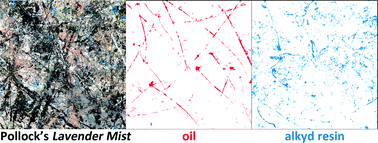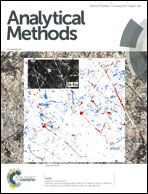Standoff chemical imaging finds evidence for Jackson Pollock's selective use of alkyd and oil binding media in a famous ‘drip’ painting
Abstract
Near-infrared diffuse reflectance imaging spectroscopy (NIR-RIS, 1000 to 2500 nm) was used to map the use of alkyd and oil paints in Jackson Pollock's Number 1, 1950 (Lavender Mist), one of his most important ‘drip’ or ‘poured’ paintings. Pollock's drip paintings were created by allowing the paint to “pour” from his brush/stick down onto the canvas. Prior analysis of micro-samples from drip paintings found Pollock was extensively using alkyd-resin paints by 1949 (in addition to oil) which led to a hypothesis that he selectively used alkyd and oil paints to obtain the fluid, gestural marks characteristic of his mature style. To determine where he used alkyd and oil paints in Lavender Mist, we utilized near-infrared spectral regions (1615–1850 and 1860–2200 nm) that allowed discrimination between these binding media, especially when the first derivative spectra were examined. The near-infrared image cubes were collected with a high-spectral resolution (2.8 nm sampling) hyperspectral camera. Using convex geometry-based multivariate analysis, three spectral endmembers were identified: oil, alkyd resin, and a third binder. The mapping results show oil binding medium was confined to the uppermost layers of the painting, corresponding with long, more-or-less straight, white skeins of paint. An alkyd binding medium maps to long white skeins of paint (both straight and curved), in addition to many irregular-shaped, disconnected regions of white and blue-green paint, indicating the mapped alkyd paint is below other layers. The third spectral endmember maps to an off-white paint that may be a mixture/layering of oil and alkyd media. X-Ray fluorescence imaging spectroscopy and site-specific reflectance spectroscopy (350–2500 nm) found evidence that the oil and alkyd white paints contain zinc and titanium whites. However, the oil paint likely contains the anatase mineral form of titanium dioxide, whereas the alkyd paint likely contains rutile titanium dioxide. As these pigments do not absorb near-infrared radiation, the mapping results demonstrate the ability to use NIR-RIS to map modern paint binders. Furthermore, the use of oil and alkyd paints seem to be intentional choices by Pollock: the oil because it has more body, and the alkyd because it is more fluid and dries more quickly.


 Please wait while we load your content...
Please wait while we load your content...